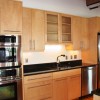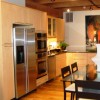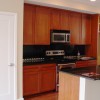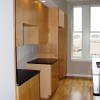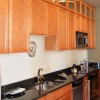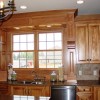Manufactured Wood Casework
Manufactured wood casework includes casework and cabinet products that are made from solid wood or have a substrate core material faced with wood veneer or plastic laminate. Manufactured wood casework is readily available from home improvement centers and material suppliers in semi-custom and stock grades, and comes assembled or ready to assemble. This type of casework is commonly installed in residential and commercial facilities, where storage or display is needed.
Casework construction can vary significantly between manufacturers and is dependent on the casework component, the material being used, and its intended use or application. Construction of components such as doors involves joining stiles with rails and panel materials. Mortise and tenon, doweled, butted, lap and beveled joints can be used, and may be incorporated using stop/moulding or cope-and-stick techniques or may employ mechanical fasteners called retainers. Construction of frame and drawers can be accomplished using dovetail, dowel, dado and rabbet, beveled or butted edge joints. Shelving is either solid or movable. Movable shelving incorporates holes for supportive pins, or uses standards that are recessed or surface mounted. Solid shelving uses biscuit, dado or doweled connections. Joining materials that are veneered or laminated do not include the use of more complex joints, such as mortise and tenon or dovetail joints, because of the finished appearance and the substrate core. Solid wood casework is often stained, and when a more complex joint is used, such as mortise and tenon or dovetail joints, the end result is the perception of higher quality.
Wood species used to manufacture solid wood cabinets include: maple, cherry, oak, pine, alder, birch, hickory, mahogany, walnut, ebony, ash, beech, elm, chestnut, butternut, rosewood and teak. Solid wood cabinets are most often stained to showcase the natural wood grain, but can also be painted, glazed or polyester. Stains can be transparent, semi-transparent, semi-opaque or opaque. When staining casework it is important to apply a protective finish coat over the stain. Painting cabinets provides a wide range of options in terms of color, texture, sheen and special effect finishes. Glaze can be tinted to any color and applied to stained, painted or bare casework. Polyester finish is similar to paint; however, it is more expensive due to labor costs. Polyester requires more wood preparation as well as sanding between coats, and the final coat requires a protective coating.
Wood-veneer-faced casework has a solid core substrate with an adhered veneer surface. Veneers are thin sheets of wood, usually less than 1/8 inch thick, sliced from a hardwood or softwood species.
Solid core substrate material can be plywood, medium density fiberboard (MDF) or particleboard. Plywood is made from adhered veneers. Medium density fiberboard is made from adhered wood fibers and resin. MDF core substrates may have an exterior resin bonded to the surface which provides for a moisture resistant substrate. Particleboard is made from adhered wood particles and resin. Particleboard is available in three categories: low density, medium density and high density, and may have special properties that make it moisture-resistant or fire-retardant.
Veneers can be plain, quarter, rift or rotary sliced. The method of cutting or slicing a veneer determines the unique characteristics of grain pattern in a veneer. Veneered casework is less expensive than solid wood, yet offers a uniform finish across surfaces and is more stable than wood. Matching patterns can be end, book, slip, random, balanced, or running matched, or they can be more customized, such as the diamond pattern. Veneers are typically prefinished or stained.
Plastic-laminate-clad casework has a solid core substrate similar to wood-veneer-faced casework, but has an adhered decorative laminate surface. In laboratory applications, a solid phenolic core is typically used as opposed to an engineered wood. The solid phenolic core substrate provides increased strength and chemical resistance. Decorative laminates can be laminated high pressure plastic, continuous pressure plastic (melamine or polyester), or thermally fused melamine. High pressure decorative plastic laminate is a thin, hard material composed of Kraft paper, resins and coatings. Thermally fused melamine is a hard surface that is fused, sealed and pressed onto particleboard or MDF substrates. Plastic-laminated-clad casework is the least expensive option for cabinets in comparison to wood or veneer casework. This type of casework offers an easy to clean, durable product, and it comes in many colors, patterns and textures.
Due to the range of materials available and the unlimited number of end use applications, there are a significant number of options in manufactured wood casework. Working with the right supplier of casework for a specific use or application, along with proper installation, will result in a quality end product that can be used for years to come.

Buildipedia Staff
The Buildipedia research and writing staff consists of dozens of experienced professionals from many sectors of the industry, including architects, designers, contractors, and engineers.
Website: buildipedia.com/

